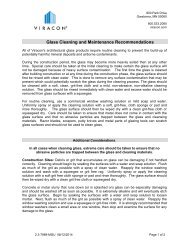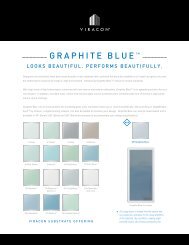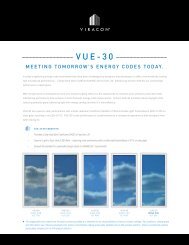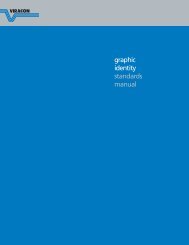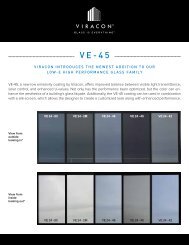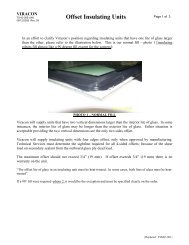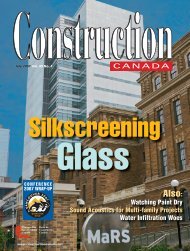Viracon's Moiré Pattern Tech Talk
Viracon's Moiré Pattern Tech Talk
Viracon's Moiré Pattern Tech Talk
Create successful ePaper yourself
Turn your PDF publications into a flip-book with our unique Google optimized e-Paper software.
viracon architectural glassT E C H T A L KMOIRÉ PATTERN
MOIRÉ PATTERNThis <strong>Tech</strong> <strong>Talk</strong> provides information on an opticalphenomenon called moiré and recommendations tominimize occurrences.introductionWhen using silkscreen patterns in architectural buildingapplications, there may be, in rare cases, a potential to seea moiré pattern develop in the glass when viewed in certainlight conditions and at specific solar angles.what is moiré?Moiré is an optical phenomenon that may present itselfas a “wavy, rippled or circular” pattern under certainconditions. Moiré patterns can be created whenever onesemi-transparent object with a repetitive pattern is placedover another. The moiré pattern is not a defect in the glassor silkscreen pattern, but rather a pattern in the imageformed by the eye.HOW THE IMAGE IS FORMEDThe moiré image is a pattern formed when two regularlyspaced patterns “overlap” and are not aligned. Inarchitectural glass applications, this may occur whensilkscreen patterns of lines or dots are closely spaced and asecondary pattern image is formed (as in the case of aninsulating glass unit or shadowbox assembly.) The“secondary” pattern can be created by the shadow ofthe ceramic frit on a second surface, as in the case of aspandrel panel installed behind the silkscreened glass.Another possibility is the second pattern may be the resultof light transmitted through the glass portion not coveredwith ceramic frit.behind the glass. Glass willreflect light from each of itssurfaces. When silkscreenpatterns are applied to the #2surface of an insulating glassunit, the image will be cast as ashadow onto the #3 glasssurface. It is the misalignment ofthe two images that causes themoiré pattern. Lighter colorssuch as white and light gray willshow these shadow patternsmore so than darker colors.recommendationsInterior Ply#1 Surface#2 Surface#3 Surface#4 SurfaceExterior PlySurface orientationAlthough it may be impossible to identify when thepotential for moiré pattern may occur, the followingglass treatments are generally more prone to exhibitingmoiré patterns.1. Closely spaced line patterns or two glass surfaceshaving a silkscreen pattern applied (insulating glass).2. Silkscreen patterns using closely spaced dots & holes.3. Insulating glass units used in spandrel areas with asilkscreen pattern on the #2 surface and full coverageceramic frit on the #3 or #4 surface.4. Highly transparent glass such as clear or Low-E coated.5. Shadow box applications with large spacing (i.e. >1/2")between the silkscreen pattern and back-up panel.6. Light colors of full coverage spandrel glass or aluminumpanels installed behind silkscreen patterns.Special consideration must be given to the selection ofcolors, silkscreen patterns and application of theseproducts since moiré patterns are not a glass defect.Viracon recommends that a full size mock-up beevaluated on all projects considering the use ofsilkscreen patterns. The mock-up should be installed atthe building site to better evaluate lighting conditionsand be viewed at different times of day and undervarying temperature conditions.Circular moiré patternThe information contained in this publication is presented in good faith.It is believed to be accurate at the time of publication.LIGHTER BACKDROPS INCREASE POTENTIALFOR OCCURRENCESThe potential for moiré patterns to occur is alsodependent upon the color of the backdrop whether it isanother lite of glass, in the case of an insulating glassunit, or when an aluminum panel is installed directly800 Park DriveOwatonna, MN 55060507.451.9555800.533.2080 (Toll Free)507.444.3555 (Within the U.S.A.)507.451.2178 (Outside the U.S.A.)E-Mail: glass@viracon.comwww.viracon.comCopyright © 2003 Viracon. All Rights Reserved.VTT-003A VRJC0604




